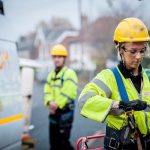Councils Object to Planning Changes for Boosting UK Mobile Cover
The National Association of Local Councils (NALC) has voiced strong opposition to new plans by the UK government, which last month proposed to simplify the planning rules (Permitted Development Rights) for new mobile infrastructure (4G / 5G masts etc.) in order to improve rural network coverage across England.
At present Ofcom’s official data (January 2019) shows that the geographic 4G (mobile broadband) coverage of the United Kingdom, from all four primary operators combined (EE, Three UK, Vodafone and O2), is currently just 67%; rising to around 91%+ when only looking at EE’s reach. Needless to say that the regulator, government and industry have been trying to improve upon that.
Officially the UK Government’s target is to extend “geographical 4G mobile coverage to 95%” by 2022, although Ofcom’s existing plan – a new coverage obligation for two operators as part of next year’s auction of the 700MHz radio spectrum band (details) – will only help to extend outdoor data coverage (3G, 4G and 5G) to “at least” 90% of the UK’s entire land area within 4 years of the award.
Advertisement
Meanwhile the industry has developed an alternative agreement for a Shared Rural Network (here), which doesn’t include a binding coverage obligation but operators claim that it could still achieve 92% without the need for tough new obligations (potentially reaching 95% by the end of 2025).
On top of that the Government is also seeking to make it easier for operators to build taller masts and related mobile infrastructure via a new consultation (here).
Mobile Planning Consultation (Permitted Development Rights)
* changing the permitted height of new masts to deliver better mobile coverage, promote mast sharing and minimise the need to build more infrastructure;
* allowing existing ground-based masts to be strengthened without prior approval to enable sites to be upgraded for 5G and for mast sharing;
* deploying radio equipment cabinets on protected and unprotected land without prior approval, excluding sites of special scientific interest; and
* allowing building-based masts nearer to roads to support 5G and increase mobile coverage.
At present 25 metres is the legal limit in England (it’s even lower in some parts of the UK), which compares with 50m in much of the EU. The advantage of taller masts is that they’re perceived to be safer (the equipment is further away from people on the ground), can cover a much wider area and you don’t need as many smaller masts when you have one big one. The old rules also seem redundant in the age of huge wind turbines.
However it’s also a well-known fact that a lot of attempts by mobile operators to expand their rural coverage have been hampered by local opposition (i.e. objections to related planning applications), which is something that the proposal would seek to avoid by making permitted development rights more flexible.
Advertisement
Suffice to say that councils are pushing back and have called upon the government to “ensure that all heights of masts are subject to a full planning application and proper consultation with local (parish and town) councils,” which sounds a lot like the current approach to us.
Cllr Sue Baxter, Chairman of NALC, said:
“NALC is pleased that the government has announced this consultation. For too long residents in rural parished areas have suffered from the dual blight of inadequate access to mobile telephone signals and very poor rural broadband connections. We hope the government will strike the right balance and secure improved signal provision without having huge masts affecting the rural skyline.”
It’s worth noting that the Government’s proposals have won support from both the Country Land and Business Association (CLA) and mobile network operators via Mobile UK. This is a crucial point since finding the right balance between land access, development and rents has frequently proven to be very problematic; much as the NALC is once again showing.
The NALC, which oddly pictured a huge electricity tower alongside its objection (very different to most thin mobile masts), has separately called for new build houses and businesses to be provided with in-built infrastructure to enable connection to fibre optic broadband.
Mark is a professional technology writer, IT consultant and computer engineer from Dorset (England), he also founded ISPreview in 1999 and enjoys analysing the latest telecoms and broadband developments. Find me on X (Twitter), Mastodon, Facebook, BlueSky, Threads.net and Linkedin.
« Plaid Cymru’s 3 Point Plan to “Eradicate” Broadband Notspots in Wales

















































Comments are closed